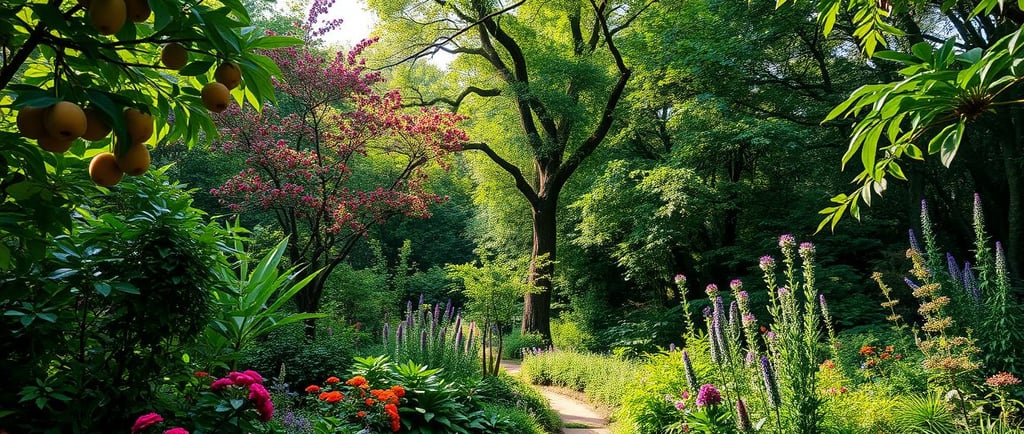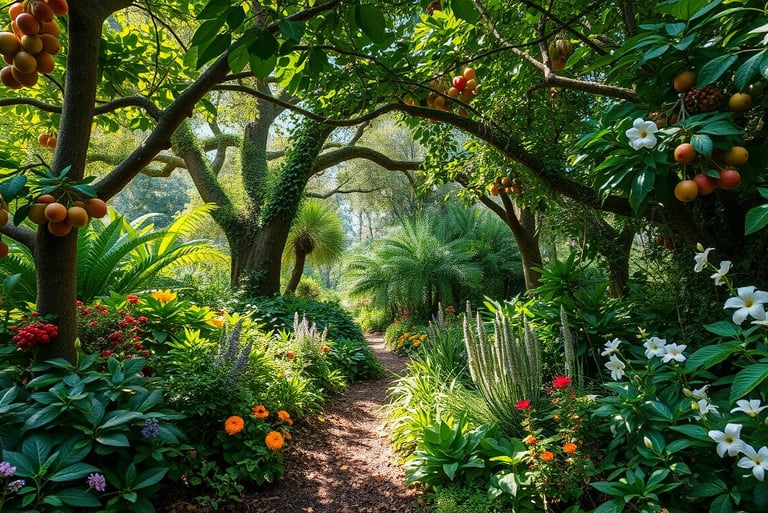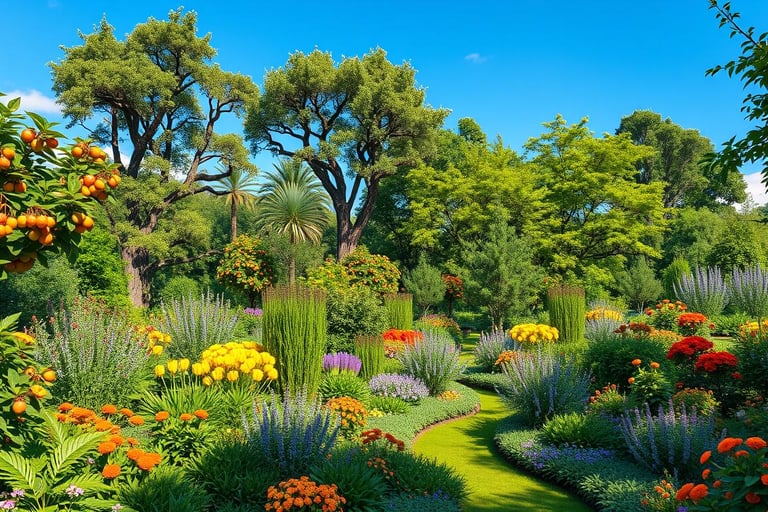Transform Your Garden Into a Food Forest
Discover how to turn your backyard into a self-sustaining food forest that provides year-round food, enhances biodiversity, and boosts soil health. Whether you're a beginner or an experienced gardener, this comprehensive guide walks you through the process of designing, planting, and maintaining a permaculture-based garden that mimics natural ecosystems. Learn how to select the best plants, improve soil fertility, and create a thriving, low-maintenance food source. Start transforming your garden into a food forest today and take a step towards a sustainable future.
PREPPING POSTS
Kathrine-Anne Hill
10/21/20246 min read


Affiliate Disclosure:
Please note that some of the links in this article are affiliate links. This means that if you click on these links and make a purchase, I may receive a small commission at no additional cost to you. This commission helps support the maintenance and growth of this website and allows me to continue providing valuable information and recommendations. Rest assured, I only recommend products and services that I have personally used or thoroughly researched. Your support is greatly appreciated! For full disclosure see our Privacy Policy and Terms and Conditions here.
Transform Your Garden into a Food Forest
Ever dreamed of a backyard full of fresh, organic food with little work? Welcome to food forests! These gardens have many layers, like a woodland, where trees, shrubs, and plants grow together. If you're over the usual lawn and flowers, it's time to see how a food forest can change your backyard.
Key Takeaways
Food forests create a self-sustaining system that produces abundant food with minimal effort.
Backyard food forests are increasingly popular in urban areas for their ability to grow a wide variety of fruits and veggies in a small space.
Preparing the soil and choosing the right plants are key to establishing a successful food forest.
With a little planning, your backyard can become a thriving, low-maintenance source of fresh produce.
Transitioning a traditional garden into a food forest requires patience, but the long-term rewards are bountiful.
In this article, you'll learn to turn your ordinary backyard into a food forest. This will give you a sustainable, year-round harvest. Get ready to unlock your outdoor space's true potential. Let's explore the secrets to creating your own backyard oasis of abundance!
What is a Food Forest?
A food forest is a lush, edible system that looks and works like a natural forest. It's a type of permaculture gardening that mixes trees, shrubs, herbs, and more. This mix creates a diverse, self-sustaining garden that needs little care.
Benefits of a Backyard Food Forest
Turning your backyard into a edible forest garden brings many benefits:
It boosts biodiversity in gardens by supporting many plants and animals.
It enhances natural ecosystem mimicry, making the environment healthier and more resilient.
Low-maintenance gardening is key once it's set up, needing less water, fertilizers, and pesticides.
You can harvest fruits, nuts, herbs, and more all year round.
It improves soil health through natural nutrient cycling and decomposition.
It also helps fight climate change by absorbing and storing carbon dioxide.
By following permaculture gardening principles, you can turn your backyard into a thriving, low-maintenance food forest. It will give you a lot of nutritious, tasty food.
"The goal of a food forest is to produce an abundance of food with minimal effort from the gardener."
How to Transition a Traditional Garden into a Food Forest
Turning your garden into a food forest is a fun and rewarding journey. It starts with preparing the soil and picking a variety of plants that work well together. Let's look at the steps to make this change successful.
The first step is sheet mulching. This method involves covering the grass with cardboard or newspaper, then adding organic materials like leaves and wood mulch. It kills the grass and weeds, and the organic matter improves the soil over time. This makes a great place for your food forest plants to grow.
Lay down a thick layer of cardboard or several sheets of newspaper over the existing lawn or garden bed.
Cover the cardboard or newspaper with a 4-6 inch layer of organic materials such as leaves, straw, wood chips, or shredded bark.
Allow the sheet mulch to decompose for several months before planting your food forest plants.
After preparing the soil, it's time to select your plants. Pick a mix of fruit trees, berry bushes, plants that fix nitrogen, and plants that gather nutrients. This mix creates a self-sustaining ecosystem where each plant helps the others grow well.
"A food forest is a layered ecosystem of plants that work together to create a self-sustaining, productive system. By mimicking the structure and diversity of a natural forest, we can grow an abundance of food with minimal maintenance."
Changing your garden to a food forest takes time and patience. But it's worth it. With good planning and care, you'll have a thriving food system for years.
Choosing Plants for Your Food Forest
Fruit Trees and Shrubs
Fruit trees are key in a food forest. If you have some already, you're on the right track. If not, pick trees that fit your local climate and pollinate well. Also, choose trees that resist common diseases.
If space is tight, go for dwarf fruit trees. They won't take over your yard. Think about how other plants will work with your fruit trees. Plants that help each other can make your garden more efficient and healthy.
A food forest has many layers, like canopy trees and ground cover. Planning is key for a thriving garden. By picking the right plants, you can make a diverse and fruitful food forest in your yard.
"A food forest can be a beautiful, productive, and low-maintenance way to grow your own food. With the right plant combinations, you can create an oasis that nourishes both you and the local ecosystem."
Designing Your Food Forest
Creating a food forest needs careful planning. You must think about where to place plants, paths, and how they will work together. It's important to know how big each plant will grow to place them right.
Start by making paths with mulch. These paths make it easy to weed, harvest, and care for your plants. Around fruit trees, use wide mulch circles. This makes caring for the trees easier as they grow. Edging along your paths can be a great addition to your food forest. The Aoipend 40 ft Garden Edging Kit comes with 36 anchoring spikes to help keep it in place. For people who don't have access to wood and wood chips for mulch , there is Jocelyn's Soil Booster Wood Chips which is available from amazon.
As your forest grows, less sunlight will reach the ground. This is because trees and shrubs will block more light. To fix this, add plants that like shade in these areas. This way, your forest works like a natural one, making it more productive.
Focus on building healthy soil and saving water to make your forest strong. Remember, a food forest is a long-term project. Plan for the future, thinking about how plants will grow. Adding an irrigation system like the TRJZWA Solar Irrigation System which can water up to 30 plants, does not need a fixed water source or power source to work, can be a great addition to your food forest.
"A food forest is a self-sustaining ecosystem designed to mimic natural systems and support a diverse array of plant species."
- Shelaigh Garson, Permaculture Land Designer
With careful planning, you can make a food forest that's both productive and easy to care for. It will give your community lots of food and medicine.
Maintenance and Benefits
Food forests are easy to care for. Once set up, they mostly take care of themselves. Plants help each other by fighting weeds, keeping moisture, and improving soil. But, you'll need to prune, weed, and harvest sometimes to keep it healthy.
The hard work pays off with a lot of food all season. A food forest also brings many benefits. It's good for plants and animals, helps fight climate change, and makes food more secure.
With some planning and care, your backyard can become a self-sustaining food forest. It's a great example of low-maintenance gardening and self-sustaining systems. It supports biodiversity, fights climate change, and boosts food security.
These statistics show the size and scope of a thriving food forest. They highlight its low-maintenance and self-sustaining nature.
"Food forests mimic natural forest structures, incorporating seven layers of plants: canopy, understory, shrub, herbaceous, ground cover, rhizosphere, and vine layers."
Food forests have different layers of plants. This diversity supports biodiversity and creates a self-sustaining ecosystem. With the right design and care, your backyard can become a vibrant, productive, and easy-to-maintain food forest.
Conclusion
Turning my garden into a backyard food forest has been rewarding. It's a self-sustaining, productive ecosystem. It feeds my family with fresh, nutritious food and helps our food systems face climate change.
By choosing the right plants and designing carefully, my food forest thrives. It's like a natural forest, with tall trees, shrubs, vines, and herbs. This setup is low-maintenance and full of life all year.
Seeing wildlife and lush growth in my food forest fills me with pride. It's a change from a traditional garden to a sustainable food system. This journey nourishes my family and helps our planet. I encourage others to start their own food forest journey.
Related Posts:
Animals in Food Forest Ecosystems: Key Players
Building a Self-Sustaining Food Forest: Permaculture Principles






